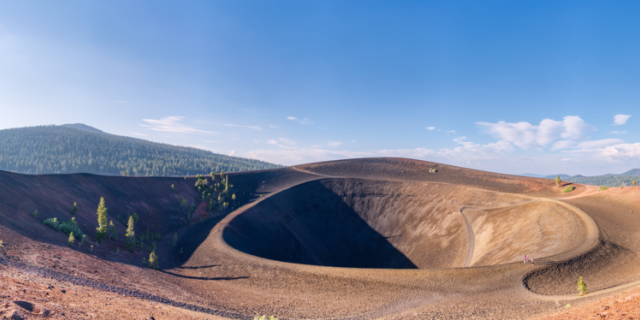Lava Beds National Monument is located in northeastern California, in Siskiyou and Modoc counties. The monument lies on the northeastern flank of Medicine Lake Volcano, which is the largest volcano by area in the Cascade Range.
The region in and around Lava Beds National Monument lies at the junction of the Sierra-Klamath, Cascade, and Great Basin physiographic provinces. The monument was established as a national monument on November 21, 1925, and includes more than 46,000 acres (190 km2).
Lava Beds National Monument has numerous lava tubes, with 27 having marked entrances and developed trails for public access and exploration. The monument also offers trails through the high Great Basin xeric shrubland desert landscape and the volcanic field. In 1872 and 1873, the area was the site of the Modoc War, involving a band led by Kintpuash (also known as Captain Jack). The area of Captain Jack's Stronghold was named in his honor.
Lava Beds National Monument includes Petroglyph Point, one of the largest panels of Native American rock art in the United States. The region was historically occupied by the Modoc people. The Lava Beds National Monument Archeological District was listed on the National Register of Historic Places in March 1991.[1]
Modoc War Captain Jack's Stronghold
Captain Jack's Stronghold
During the Modoc War of 1872–1873, warriors of a band led by Kintpuash (Captain Jack) used the lava beds as a defensive stronghold to resist being captured and returned to the Klamath Reservation in Oregon, to which they had been removed, as European Americans wanted their lands. The Modoc took refuge in a natural lava fortress that was later named Captain Jack's Stronghold. From this defensive base, a group of 53 fighting men and their families held off US Army forces, amounting to ten times the Modocs' population, for five months.
In April 1873, at a peace commission meeting, Captain Jack killed General Edward Canby while associates killed Reverend Eleazer Smith and wounded two other commissioners. Canby was the only casualty of the Indian Wars who had the rank of general at the time of his death. The Modoc mistakenly thought the Americans would leave if their leaders were killed. Instead Army reinforcements were brought in and the Modoc were eventually forced to surrender. Kintpuash and his associates were convicted of war crimes for the murders, and executed by hanging at Fort Klamath.
Establishment of the monumentAn early steward for the land was J. D. Howard, a miller residing in Klamath Falls. He explored the area intimately beginning in 1917, naming geographic features and making caves accessible. With the area growing attention, he noticed visitors beginning to damage the cave features.[2]
Howard's perceived need to preserve the lava tubes and the area's other geological features was a major reason why he vigorously pushed for a federally protected status.[3] He would photograph interiors of each cave as part of an effort to persuade people to protect the area. In a letter written in 1923, Howard urged United States Forest Service officials, state legislators, and community leaders to declare the caves a park; "This is the last of Park sites in the States, and is far Superior to all the others as it embraces enough phenomena to keep one busy for at least Three Month Sight Seeing with Cap Jack’s Stronghold to study on leisure hours."[2]
Howard's campaign was successful, as Lava Beds National Monument was signed into existence by President Calvin Coolidge on November 21, 1925.[4] It was created under the auspices of the 1906 Antiquities Act.[2]
Later expansionThe only expansion in the modern era occurred in 2011 when the monument expanded by roughly 132 acres (53 ha). An administrative transfer brought two parcels of land which were previously managed by the Bureau of Reclamation and the Bureau of Land Management into National Park Service management. These two parcels adjoin the Petroglyph Point Unit of the monument.


































Add new comment